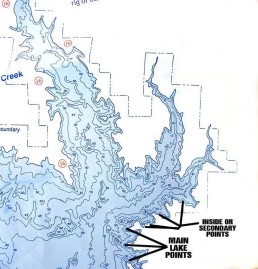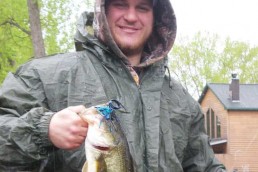Research Equals Results
SHARE THIS POST
I quit tournament fishing in 2003, and for the most part, I don’t miss it. What I do miss is the “figuring out” and the “exploring,” the breaking down a body of water I’d never seen before or hadn’t been to in some time. Where are the fish holding? Are they spawning? Are they on the move? What are they eating?
These questions must be answered to put together a solid pattern. A tournament angler may get a few practice days to build a pattern, however the weekend angler might only have one. That Saturday they’ve been waiting for when there are no ball games for the kids, no weddings, no yard work, nothing—just that special day when an angler can say, “Gone Fishin’.”
So how do we put a pattern together in that day? For starters, don’t wait for “that day.” Now you can’t actually put a pattern together until you have caught a few fish, but you can give yourself an advantage. Get a head start by doing research at home.
Check online to see what the bite is like at Lake X? Are the walleyes hitting cranks or live bait? Is the topwater bite happening? On my website, fishnfunokoboji.com, the fishing report page is by far the most viewed page. The Iowa DNR has a site that’s a wealth of information on the lakes here. And most quality bait and tackle shops have websites and Facebook pages.
Check the weather and track water temperatures, if possible. This is extremely important in the spring; we need to know where the fish are in relation to the spawn. Different species spawn at different times and water temperature and length of day seem to be the determining factors. If you don’t know when to target species and the spawn, research it. Also, research what type of bottom they prefer when spawning: hard or soft bottom, bull rushes, rock or gravel. All of these are spawning areas. When the spawn is over, think about their food because that will dictate where a fish spends the rest of the year.
Learn what prey is available. In many of the reservoirs in Iowa, shad are the main forage. In our natural lakes, minnows and shiners are the dominant baitfish. Bluegills and crawdads are available forage in nearly every body of water in Iowa. Knowing what feed is available helps an angler narrow the search. If I was chasing bass on a natural lake during late spring or early summer, the first place I would look are areas where bluegills spawn. Find these large populations of bluegills and you will find bass feeding on them. On a shad-based reservoir in midsummer, I know I’m going to be looking in open water for big schools of baitfish. The more we know about the baitfish in a particular body of water, the faster we can find the gamefish.
Most of our homework is done and we have studied gamefish movements from ice-out through fall; we know what type of baitfish our chosen body of water has available. Now, it’s time to make an educated guess based on our knowledge and time of year or seasonal pattern as to where the gamefish will be.
How do we do that at home? Get a lake map and study it.
At ice-out, most species will still be near wintering areas including points, humps and flats with immediate access to deep water. Mark all of the areas that fit this criterion. I use different color Sharpie pens to mark different types of areas. Designate different colors for different times of year. I will circle an area in black and write “wintering area.” A “spawning area” will be in red, “summer” in green, etc. Then use the same colors for all of your maps, as there will be overlapping areas.
As the water warms in spring, offshore areas become less populated as fish move toward spawning areas. Highlight these spawning areas. This is a gradual process and not all fish move at the same time. They meander, stopping to feed. Male fish are usually the first to arrive at spawning areas and the last to leave. Spring cold fronts halt the process and warming trends can accelerate it, so transition zones become important, specifically drop-offs on the edge of spawning flats. Highlight these areas.
After the spawn, all that’s left for the year is to eat and don’t get eaten. Structure and cover help a fish accomplish these goals, and lakes and reservoirs have some type of structure. However, many larger reservoirs are lacking in cover.
Are you enjoying this post?
You can be among the first to get the latest info on where to go, what to use and how to use it!
Structure is permanent, and part of the lake’s infrastructure, much like the foundation of a house. These include flats, points, drop-offs, humps, bridge pilings and creek or river channels. I personally don’t consider flooded trees in a reservoir, structure. However, I do consider distinct edges formed by a large group of trees structure. This edge often coincides with a drop-off into a creek or river channel.
Cover is not permanent and is susceptible to change. Cover consists of weeds, flooded brush, the shade of a dock, downed trees, manmade brush piles and boat hoist; cover located on a structural element is ideal.
We’ve studied the lake and the fish habits. We know what baitfish are prevalent in the system and we have watched the weather patterns for the past week.
So where do we start?
For me, that decision is the last piece of homework. I take all the information from my marked maps and the seasonal patterns and match them to the LakeMaster map in my Humminbird. I will generally pick six prime spots and place an icon on these spots. I want spawning/feeding areas, access to deep water and a combination of structure and cover. One thing you will see quickly is these are often community spots that get fished—don’t let that worry you.
Attack these spots; fish as aggressively as conditions will allow. Your target is the most active fish. Start with a lure that covers a lot of water effectively, like a crankbait or a buzzbait or jig, but don’t crawl it, snap it up and let it fall. You get the idea. Cover water, move, attack, and make something happen. I remember a guide trip on Little River Lake in southern Iowa back in the early ‘90s. The walleyes had been on the tips of points for nearly a month. We had fished a few spots like that vertical jigging with nothing to show for it. So I fired a cast up shallow into 6 to 7 feet of water. My jig never made it to the bottom. We moved shallow and immediately started catching walleyes.
Mix it up and don’t get lazy. If you are fishing by yourself, work these prime areas with at least three to four different presentations. With two or more anglers in the boat, each should offer a different type of presentation. The first one should be the most aggressive, than one a little slower, and finally a subtle temptation. Make casts from multiple angles. I’ve seen times when working a lure from deep to shallow resulted in zero bites. I reversed it and went from shallow to deep and the bite was fast and furious. This is especially important when current is involved, like in a river or reservoir or when wind creates current in a natural lake. A general rule is, the more current, the shallower the active fish will be. Remember that shallow is relative to the seasonal pattern the fish are in.
What happens when the fish aren’t set up on these prime spots? Unfortunately this happens, perhaps due to weather changes or fishing pressure. Now, we move to the secondary locales. This might be an inside turn or cup. Maybe they moved tight to cover like laydown logs or docks. Maybe they moved offshore and are suspending. When we did our home research we should have marked these secondary spots so we have a plan on how to fish them.
The better our game plan is laid out before we get to the lake, the better our chances are for success. Have a plan and then also have a backup plan.
Doug Burns owns and operates The Iowa Guide service. For more info visit fishnfunokoboji.com.
MWO
SHARE THIS POST
Did you enjoy this post?
You can be among the first to get the latest info on where to go, what to use and how to use it!
MWO
We believe being outdoors is good. With more than 1,000 articles each year, MidWest Outdoors magazine is all about sharing outdoor experiences with you—where to go, what to use and how to use it… whether you’re close to home or on that trip of a lifetime.



